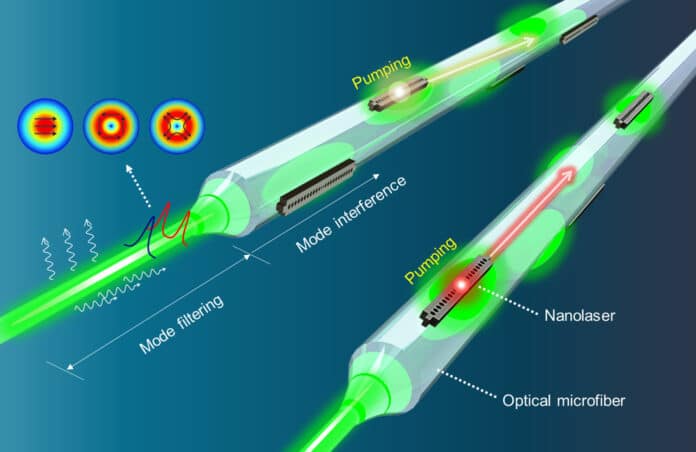Efficient programming of integrated small optical sources is a key component of photonic technologies. However, as the density of laser arrays increases, the miniaturization and scalability of laser control using an electric drive are pushed to the limit.
Scientists have developed a new all-optical method for driving multiple highly dense nanolaser arrays. These nanolaser arrays- in which the lasers are just 18 microns apart- can be fully driven and programmed with light from a single optical fiber. The approach could enable chip-based optical communication links that process and move data faster than today’s electronic-based devices.
Research team leader Myung-Ki Kim from Korea University said, “The development of optical interconnects equipped with high-density nanolasers would improve information processing in the data centers that move information across the internet. This could allow streaming of ultra-high-definition movies, enable larger-scale interactive online encounters and games, accelerate the expansion of the Internet of Things, and provide the fast connectivity needed for big data analytics.”
“Optical devices integrated onto a chip are a promising alternative to electronic integrated devices, which are struggling to keep up with today’s data processing demands. By eliminating the large and complex electrodes typically used to drive laser arrays, we reduced the overall dimensions of the laser array while also eliminating the heat generation and processing delays that come with electrode-based drivers.”
The new nanolasers could be applied to optical integrated circuit systems, which use light to detect, produce, transmit, and process data on a microchip. Optical waveguides are utilized in optical circuits in place of the thin copper wires in electronic chips because they enable substantially larger bandwidths while producing less heat. However, new approaches are required to effectively drive and regulate their nano-sized light sources because the scale of optical integrated circuits is rapidly approaching the nanometer regime.
Lasers require energy to emit light, which is provided through a process known as pumping. This is commonly done for nanolaser arrays utilizing a pair of electrodes for each laser inside an array, which consumes a lot of space and energy on the chip and slows down processing. The scientists swapped these electrodes for a special optical driver that uses interference to create customizable light patterns to get around this critical limitation. An optical cable that has nanolasers printed on it carries this pump light.
To illustrate this strategy, the scientists created many photonic crystal nanolasers that were 18 microns apart using a high-resolution transfer printing process. A 2-micron-diameter optical microfibre surface was covered with these arrays. The interference pattern required to be perfectly aligned with the nanolaser arrays in order for this to be done. The interference pattern may also be changed by varying the pulse width and polarisation of the driving beam.
The investigations demonstrated that the architecture enabled the driving of several nanolaser arrays with light passing through a single fiber. The results demonstrated that the printed nanolaser arrays could be completely controlled by the pump beam interference patterns and agreed well with numerical calculations.
Kim said, “Our all-optical laser driving and programming technology can also be applied to chip-based silicon photonics systems, which could play a key role in developing chip-to-chip or on-chip optical interconnects. However, it would be necessary to prove how independently the modes of a silicon waveguide can be controlled. If this can be done, it would be a huge leap forward in the advancement of on-chip optical interconnects and optical integrated circuits.”
Journal Reference:
- Da In Song, Aran Yu, Polnop Samutpraphoot, Jungmin Lee, Moohyuk Kim, Byoung Jun Park, Alp Sipahigil, Myung-Ki Kim. Three-dimensional programming of nanolaser arrays through a single optical microfiber. Optica, 2022; 9 (12): 1424 DOI: 10.1364/OPTICA.471715
